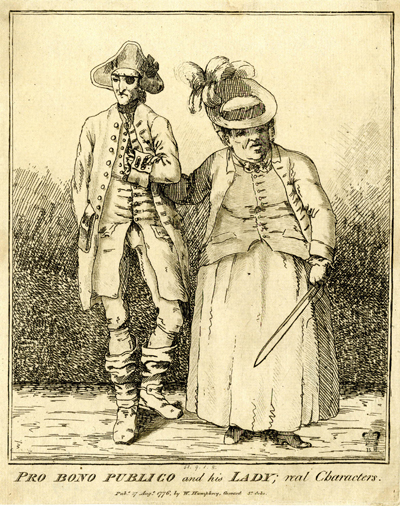Pro Bono Publico and his Lady
From a stylistic point of view, Pro Bono Publico and his Lady certainly looks like a print by John Hamilton Mortimer. The fullness and sense of depth in the figures, the manner of shading, and the overall sophistication of the print-making—all point to Mortimer as the author. Even the title looks like the titles of nearly contemporaneous prints by Mortimer such as Twelve Characters from Shakespeare. See, for instance, Caliban [1775].

© Trustees of the British Museum
But as Draper Hill points out, Mortimer had no previous connection with William Humphrey (the print publisher). And, as in Sixpence a Day, the subject matter seems very close to Gillray's own experience. Gillray's father was, after all, a war veteran, and, like the man in the print, had lost his right arm in public service, fighting in 1745 as part of the 7th Dragoons in the War of the Austrian succession. The man in the print is indeed dressed not simply in riding habit, as M. Dorothy George says in her commentary on this print, but in a fashion which seems to be reminiscent of the uniform of a dragoon from 1745. And of course the title suggests that the man is indeed a war veteran, someone who has given his arm and his eye "pro bono publico," for the public good, someone who now needs to be driven in a carriage by his "Lady" (hence the buggy whip).
If this is indeed a print by the young Gillray, I can't help but wonder if these "Real Characters," as the subtitle insists, aren't indeed based on Gillray's parents, the only real characters who would have lent themselves to being studied for such a careful composition by a young and still unknown artist.
Sources and Reading
- Commentary from the British Museum on Pro Bono Publico and his Lady.
- Draper Hill, Mr. Gillray The Caricaturist, 1965
Comments & Corrections
NOTE: Comments and/or corrections are always appreciated. To make that easier, I have included a form below that you can use. I promise never to share any of the info provided without your express permission.